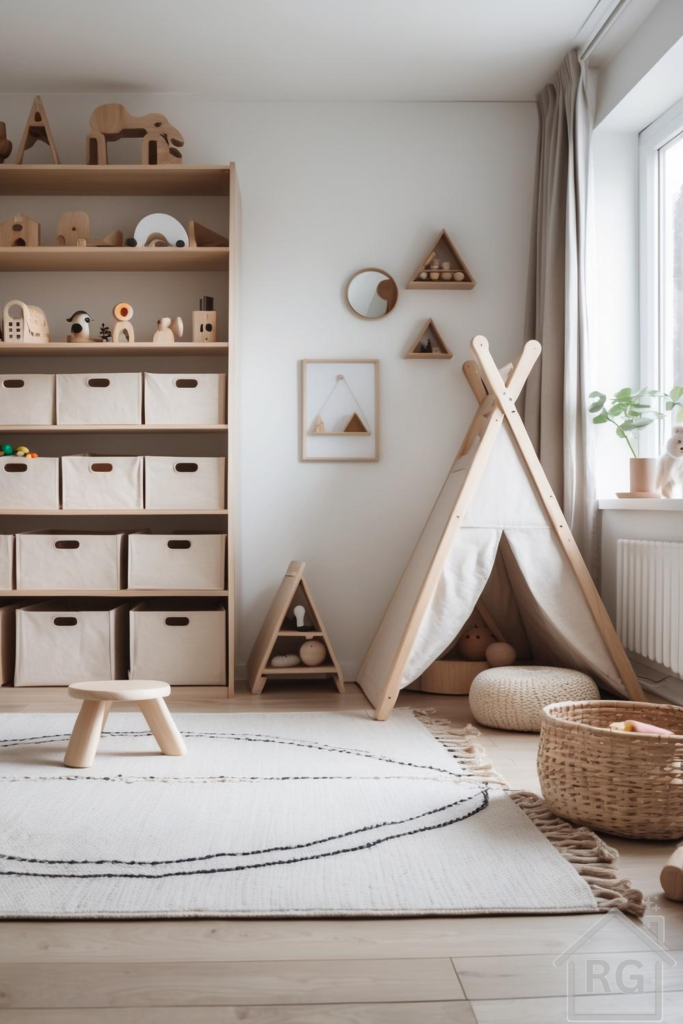
Designing a dedicated play space that’s both engaging and calming can seem challenging. However, the Montessori philosophy provides an excellent blueprint for creating a room that encourages independence, creativity, and peace. This beautiful neutral playroom perfectly embodies these principles – offering a serene, organized, and inviting environment crafted with natural materials and a soothing color palette.
If you’re inspired to create a similar haven for your child, this guide will walk you through the essential elements and provide actionable steps to bring this vision to life in your own home.
Understanding the Montessori Philosophy in Design
The Montessori approach centers on child-led learning, fostering independence, and respecting a child’s natural developmental path. Applied to room design, this translates into several key concepts:
- Accessibility: Furniture and materials are child-sized and placed within easy reach, empowering children to interact with their environment independently.
- Order: A designated place for everything promotes tidiness, respect for belongings, and a sense of calm predictability.
- Simplicity: Avoiding overstimulation through minimal clutter and a calming aesthetic helps children focus and engage more deeply.
- Natural Materials: Prioritizing wood, cotton, wool, and other natural elements connects children to the natural world and offers rich sensory experiences.
- Freedom of Movement: Ample clear floor space allows for unrestricted exploration, movement, and different types of play.
Deconstructing the Look: Key Elements of This Neutral Playroom
Let’s break down the components that contribute to the success of this calming and functional neutral playroom:
1. The Soothing Color Palette
The room’s foundation is its neutral color scheme. Soft off-white or very light beige walls create a bright, airy backdrop. This is layered with various shades of beige in storage bins, the teepee fabric, a woven pouf, and curtains. The dominant accent is the warm, light natural wood tone found in the shelving unit, stool, toys, and teepee frame. A subtle touch of contrast comes from the dark grey/black lines on the rug, grounding the space without being visually jarring. This carefully limited palette minimizes visual noise, promoting focus and tranquility.
2. Emphasis on Natural Textures
Texture adds depth and sensory interest, especially crucial in a neutral space. This room masterfully incorporates:
- Wood: Smooth, warm wood is used for furniture, shelving, and toys – chosen for its durability, timeless appeal, and calming quality.
- Canvas/Cotton: Found in storage bins, the teepee cover, and potentially the rug, these fabrics offer softness and a pleasant tactile experience.
- Woven Materials: Rattan or seagrass baskets and woven poufs introduce varied natural textures, adding visual interest and a slightly rustic feel.
- Wool/Cotton Blends: Rugs made from these blends are soft underfoot yet durable, with details like tassels adding further textural elements.
3. Child-Centric Furniture Choices
- Open Shelving: The tall, open shelving unit is key. It displays toys attractively and allows children easy access. Using uniform storage bins on lower shelves keeps smaller items contained and maintains visual order.
- Teepee Tent: A canvas teepee provides a cozy, defined space for reading, quiet time, or imaginative play, aligning with the natural aesthetic.
- Low Stool: A small, sturdy wooden stool offers appropriately sized seating.
- Soft Floor Coverings: A cream rug defines the main play area, adds warmth, and provides a soft surface. A woven pouf offers flexible additional seating.
4. Purposeful Toy Selection & Storage
The visible toys are primarily wooden, suggesting a focus on open-ended play items like stackers, figures, and blocks. The storage system is crucial: easily accessible bins encourage children to participate in tidying up. This setup perfectly facilitates the Montessori principle of toy rotation (keeping only a curated selection out at once) to maintain engagement and reduce clutter.
5. Minimalist & Natural Decor
Decor is kept simple and natural. Small shelves display select items, a round mirror adds light, and simple framed art complements the theme. A small potted plant brings nature indoors. The emphasis is clearly on quality over quantity.
How to Achieve This Look: Practical Tips
Ready to create your own serene Montessori-inspired playroom? Here’s how:
- Start with the Palette: Choose a base neutral (off-white, cream, light grey) for walls. Layer shades of beige, tan, and ivory through textiles. Use natural wood tones as your primary accent.
- Prioritize Natural Materials: Invest in solid wood furniture (or quality veneer). Choose rugs made from wool or cotton, and storage baskets from seagrass or rattan.
- Select Accessible Storage: Opt for low, open shelving (cube units work well). Use matching bins or baskets for smaller toys. Consider picture labels for pre-readers.
- Choose Furniture Wisely: Ensure tables, chairs, and stools are child-sized. Include a cozy element like a teepee, canopy, or floor cushions.
- Curate Toys: Focus on quality, open-ended toys, preferably made from natural materials. Implement a toy rotation system.
- Layer Textures: Combine smooth wood, soft cotton, nubby wool, and woven elements for sensory richness.
- Keep Decor Simple: Select a few meaningful pieces. Avoid overly stimulating patterns. Add a plant for a touch of life.
- Maximize Natural Light: Use simple window treatments that allow ample daylight.
- Maintain Order: Regularly declutter and involve your child in tidying up. An organized space is key to the Montessori method.
Beyond Aesthetics: The Benefits of a Montessori Play Space
A playroom designed with these principles offers significant advantages beyond just looking good. The calm atmosphere can reduce overstimulation and anxiety, promoting better focus during play. The emphasis on natural materials provides rich sensory experiences vital for development. Furthermore, the organized layout and accessible storage foster independence, responsibility, and respect for belongings.
Ultimately, creating a serene, neutral, Montessori-inspired playroom is an investment in your child’s development and well-being. By focusing on a calming palette, natural textures, accessible storage, and child-led principles, you design a beautiful, functional space that supports peaceful play, learning, and growth for years to come.
